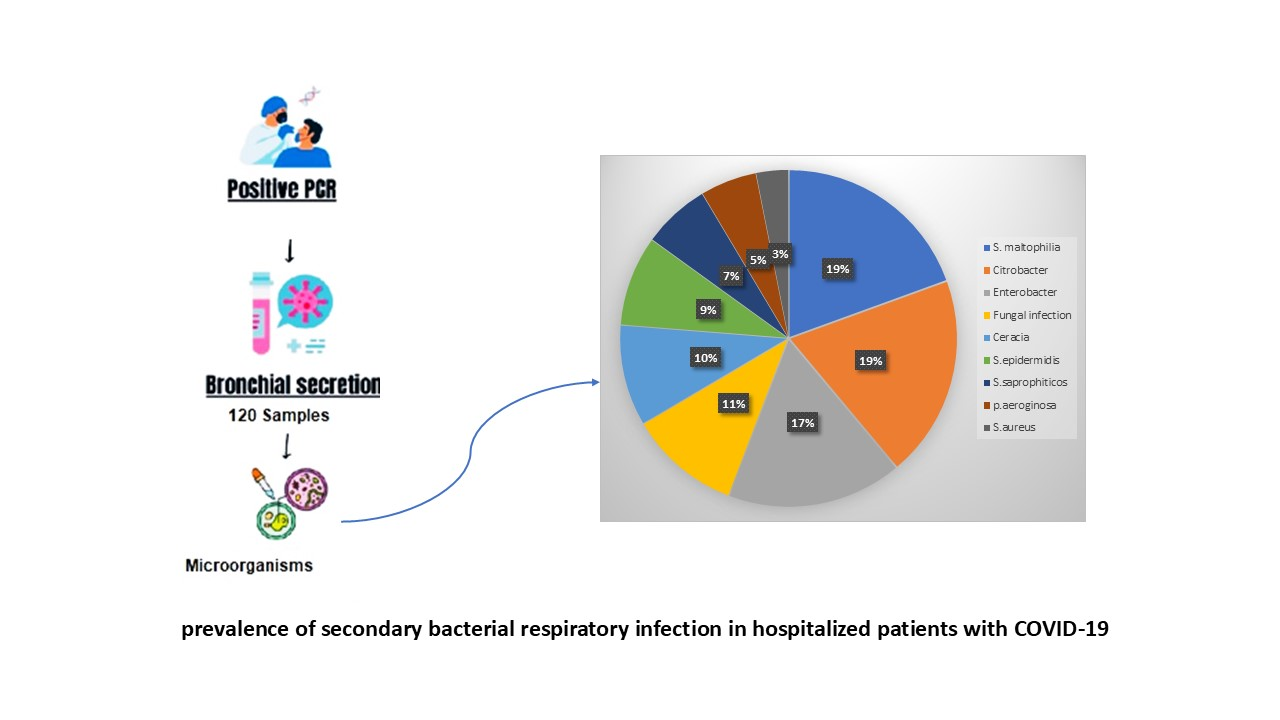Volume 35, Issue 246 (7-2025)
J Mazandaran Univ Med Sci 2025, 35(246): 191-196 |
Back to browse issues page
Download citation:
BibTeX | RIS | EndNote | Medlars | ProCite | Reference Manager | RefWorks
Send citation to:



BibTeX | RIS | EndNote | Medlars | ProCite | Reference Manager | RefWorks
Send citation to:
Rahimzadeh G, Vahedi Larijani L, Amini Y, Esmaeili Reykande S, Sheidaei S. Investigation of the Prevalence of Secondary Bacterial Respiratory Infections in Hospitalized COVID-19 Patients at sari Imam Khomeini Hospital. J Mazandaran Univ Med Sci 2025; 35 (246) :191-196
URL: http://jmums.mazums.ac.ir/article-1-21803-en.html
URL: http://jmums.mazums.ac.ir/article-1-21803-en.html
Golnar Rahimzadeh 
 , Laleh Vahedi Larijani
, Laleh Vahedi Larijani 
 , Yasaman Amini
, Yasaman Amini 
 , Samira Esmaeili Reykande
, Samira Esmaeili Reykande 
 , Somayeh Sheidaei
, Somayeh Sheidaei 


 , Laleh Vahedi Larijani
, Laleh Vahedi Larijani 
 , Yasaman Amini
, Yasaman Amini 
 , Samira Esmaeili Reykande
, Samira Esmaeili Reykande 
 , Somayeh Sheidaei
, Somayeh Sheidaei 

Abstract: (276 Views)
Background and purpose: Secondary bacterial respiratory infections are common and serious complications in patients with COVID-19. These infections can hinder treatment, leading to prolonged hospital stays, increased healthcare costs, and extensive antibiotic use. This study aimed to investigate the prevalence of secondary bacterial infections in respiratory samples of COVID-19 patients hospitalized at Imam Khomeini Hospital in Sari, Iran.
Materials and methods: This descriptive cross-sectional study was conducted on 120 hospitalized COVID-19 patients with confirmed secondary bacterial respiratory infections. Eligible patients had a positive real-time polymerase chain reaction (RT-PCR) test, fever, leukocytosis, and radiological evidence of pulmonary involvement. Demographic information, hospitalization ward (general or intensive care unit), underlying medical conditions, and bacterial isolates from respiratory samples were collected.
Results: Of the total patients, 57.5% were male, with a mean age of 63.16 ± 15.08 years. Statistical analysis revealed no significant associations between secondary bacterial infections and underlying conditions such as cardiovascular disease, chronic kidney or pulmonary disease, dialysis, diabetes, cancer, hypertension, immunosuppressive therapy, thyroid disorders, or type of hospital ward. The most frequently isolated bacteria were Citrobacter and Stenotrophomonas maltophilia.
Conclusion: The results of this study demonstrate a high frequency of secondary bacterial infections among hospitalized COVID-19 patients. Although certain pathogens were more frequently isolated, there was no statistically significant correlation between these infections and comorbidities or hospitalization unit. The findings underscore the importance of rapid and accurate identification of such infections, continuous monitoring of hospitalized patients, particularly in healthcare settings with high-risk individuals, and the implementation of appropriate strategies for the timely management and treatment of secondary infections. Such an approach can not only improve the prognosis of patients with COVID-19 but also help prevent the spread of antibiotic resistance resulting from inappropriate antimicrobial therapy.
Materials and methods: This descriptive cross-sectional study was conducted on 120 hospitalized COVID-19 patients with confirmed secondary bacterial respiratory infections. Eligible patients had a positive real-time polymerase chain reaction (RT-PCR) test, fever, leukocytosis, and radiological evidence of pulmonary involvement. Demographic information, hospitalization ward (general or intensive care unit), underlying medical conditions, and bacterial isolates from respiratory samples were collected.
Results: Of the total patients, 57.5% were male, with a mean age of 63.16 ± 15.08 years. Statistical analysis revealed no significant associations between secondary bacterial infections and underlying conditions such as cardiovascular disease, chronic kidney or pulmonary disease, dialysis, diabetes, cancer, hypertension, immunosuppressive therapy, thyroid disorders, or type of hospital ward. The most frequently isolated bacteria were Citrobacter and Stenotrophomonas maltophilia.
Conclusion: The results of this study demonstrate a high frequency of secondary bacterial infections among hospitalized COVID-19 patients. Although certain pathogens were more frequently isolated, there was no statistically significant correlation between these infections and comorbidities or hospitalization unit. The findings underscore the importance of rapid and accurate identification of such infections, continuous monitoring of hospitalized patients, particularly in healthcare settings with high-risk individuals, and the implementation of appropriate strategies for the timely management and treatment of secondary infections. Such an approach can not only improve the prognosis of patients with COVID-19 but also help prevent the spread of antibiotic resistance resulting from inappropriate antimicrobial therapy.
Keywords: Secondary bacterial respiratory infection, nosocomial infection, COVID-19 pandemic, respiratory secretions
Type of Study: Brief Report |
Subject:
infection
Send email to the article author
| Rights and permissions | |
 |
This work is licensed under a Creative Commons Attribution-NonCommercial 4.0 International License. |





